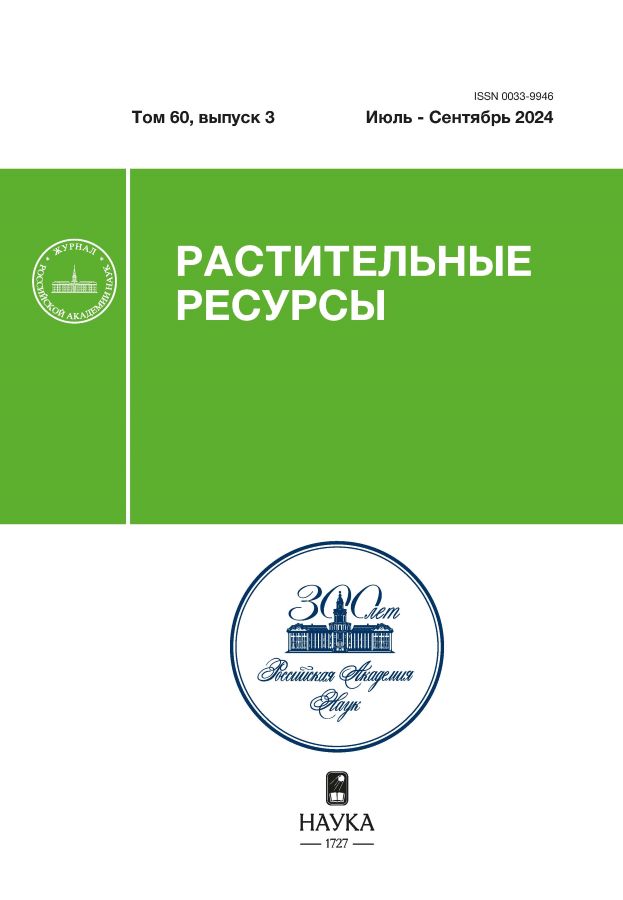Assessment and population strategy of Medicago falcata (Fabaceae) in Southern Siberia
- Authors: Karnaukhova N.A.1, Dorogina O.V.1
-
Affiliations:
- Central Siberian Botanical Garden SB RAS
- Issue: Vol 60, No 3 (2024)
- Pages: 88-98
- Section: Structure of Plant Populations
- URL: https://ruspoj.com/0033-9946/article/view/674403
- DOI: https://doi.org/10.31857/S0033994624030063
- EDN: https://elibrary.ru/PTUCQS
- ID: 674403
Cite item
Abstract
In Siberia (Novosibirsk region, Altai Republic and Khakassia), 12 coenopopulations of Medicago falcata L. were studied in different growing conditions. The most important indicators operating at the organismal and population levels were studied, adaptation mechanisms were identified and the strategy of the species was determined. A score is given for 5 organismal and 5 population indicators in each habitat. The maximum sum of points in meadow-steppe habitat conditions characterizes the optimal state of the species. The pessimal state is determined by the minimum values of most parameters of the species. It was found in steppe habitats subject to heavy grazing with stages III–IV of pasture digression. It has been established that in anthropogenic habitats M. falcata can exist on the territory for a long time due to a decrease in the vitality of individuals and a tolerant strategy.
Full Text
About the authors
N. A. Karnaukhova
Central Siberian Botanical Garden SB RAS
Author for correspondence.
Email: karnaukhova-nina@rambler.ru
Russian Federation, Novosibirsk
O. V. Dorogina
Central Siberian Botanical Garden SB RAS
Email: olga-dorogina@yandex.ru
Russian Federation, Novosibirsk
References
- Kultiasov I. M., Grigorieva N. M. 1978. [Genus Medicago L.]. — In: [Biological flora of the Moscow region]. Moscow. 4: 96–112. (In Russian)
- https://meadow_herbaceous_plants.academic.ru/166/люцерна_серповидная_%28medicago_falcata_L.%29 (Accessed 24.01.2023)
- Atlasova L. G. 2011. The state of the cenopopulations of Medicago falcata L. in the conditions of Central Yakutia. ― News of the Samara Scientific Center of the Russian Academy of Sciences. 13, 1(4): 770–772. (In Russian)
- Karnaukhova N. A., Syeva S. Ya. 2023. Feed Characteristics and State of Medicago falcata L. Cenopopulations in Siberia. ― Timiryazev Biological Journal. 2: 6–18. https://doi.org/10.26897/2949-4710-2023-2-6-18 (In Russian)
- Atlasova L. G. 2018. Vitality and variablity of morpfological parameters of Medicago falcata L. and Medicago × varia L. under conditions of the Middle Lena River valley. ― Bulletin of KSAU. Krasnoyarsk. 5: 16–22. (In Russian)
- [Plant resources of the USSR: Flowering plants, their chemical composition, use. Family Hydrangeaceae–Haloragaceae]. 1987. Leningrad. 326 p. (In Russian)
- Shvets N. N., Sukhomlinov Yu. A., Bubenchikov R. A. 2023. Study of the antioxidant activity of the herb alfalfa sickle (Medicago falcata L.). ― Humans and their health. 26(2): 86–92. https://doi.org/10.21626/vestnik/2023-2/11. EDN: ZIZCIE. (In Russian)
- Redkin P. P. 2005. [Obtaining a trypsin inhibitor from alfalfa and its effect on the physiological functions of the dog’s body. Abstr. … Dis. Candidate (Biology) Sci.]. Kursk. 18 p. (In Russian)
- Amaresh Chandra, Krishna Chandra Pandey. 2011. Assessment of genetic variation in lucerne (Medicago sativa L.) using protease inhibitor activities and RAPD markers. ― J. Environ. Biol. 32(5): 559–65.
- Abdushaeva Ya. M. 2022. Ecological and biological assessment of sickle alfalfa (Medicago falcata L.) in natural communities of the Novgorod Region. ― AgroEkoInzheneriya. 4(113): 50–57. https://doi.org/10.24412/2713-2641-2022-4113-50-57 (In Russian)
- Malysheva N. Yu., Malyshev L. L. 2020. An analysis of the Medicago falcata s.l. alfalfas collected in the ex-USSR territories for the fullness of their coverage. ― Proceedings on Applied Botany, Genetics and Breeding. 181(3): 17–24. https://doi.org/10.30901/2227-8834-2020-3-17-24 (In Russian)
- Snagovskaya M. S. 1965. [Main features of the large development cycle and population composition of yellow alfalfa in Oka meadows. Abstr. … Dis. Candidate (Biology) Sci.]. Moscow. 19 p. (In Russian)
- Grigorieva N. M. 1983. [Sickle alfalfa (Medicago falcata L.)]. ― In: [Diagnoses and keys of age conditions of meadow plants. Part 2.]. Moscow. P. 55–61. (In Russian)
- Zhukova L. A. 1986. [Polyvarience of meadow plants ontogenesis]. ― In: [Life forms in ecology and systematics of plants]. Moscow. P. 104–112. (In Russian)
- Mikhajlovskaya I. S. 1972. Ontogenetic anatomo–morpholodgical changes in the underground organs of Medicago falcata L. ―Bulletin of Moscou Society of Naturalists. Biological series. 77(1): 88–101. (In Russian)
- Zaugolnova L. B., Smirnova O. V., Komarov A. S., Khanina L. G. 1993. Monitoring of phytopopulations. ― Advances in Current Biology. 113(4): 410–414. (In Russian)
- Zaugolnova L. B., Denisova L. V., Nikitina S. V. 1993. Principles and methods for assessing the status of populations. ― Bulletin of Moscou Society of Naturalists. Biological series. 98(5): 100–106. (In Russian)
- Zaugolnova L. B. 1994. [The structure of populations of seed plants and problems of their monitoring: Abstr. … Dis. Doct. (Biology) Sci.]. St. Petersburg. 70 p. (In Russian)
- Grigorieva N. M. 1975. [Age and spatial structure of the cenopopulations of yellow alfalfa (Medicago falcata L.).: Abstr. … Dis. Doct. (Biology) Sci.]. Mosсow. 24 p. (In Russian)
- Odum Y. 1986. Ecology. Mosсow. Т. 2. 209 p. (In Russian)
- Zhukova L. A. 1987. [Dynamics of cenopopulations of meadow plants.: Abstr. … Dis. Doct. (Biology) Sci.]. Novosibirsk. 32 p. (In Russian)
- Rabotnov T. A. 1950. [Issues of studying the composition of populations for the purposes of phytocenology]. ― In: [Problems of botany: Vol. 1]. Moscow, Leningrad. P. 465–483. (In Russian)
- Uranov A. A. 1975. Age spectrum of phytocenopopulation as a function of time and energy wave processes. ― Biol. Sciences. 2: 7–34. (In Russian)
- [Cenopopulations of plants (basic concepts and structure)]. 1976. Moscow. 215 p. (In Russian)
- [Cenopopulations of plants (essays on population biology)]. 1988. Moscow. 184 p. (In Russian)
- Vainagij I. V. 1973. Methodology for statistical processing of material on seed productivity using the example of Potentilla aurea L. — Rastitelnye resursy. 9(2): 287–296. (In Russian)
- Vainagij I. V. 1974. On the methodology for studying seed productivity of plants. — Botanical Journal. 59(6): 826–831.
- Zhukova L. A. 1995. [Population life of meadow plants]. Yoshkar-Ola. 224 p. (In Russian)
Supplementary files











